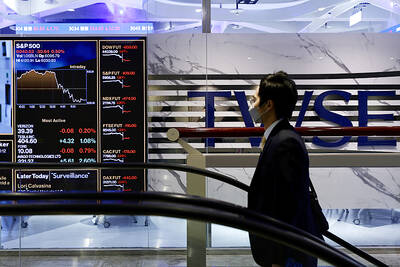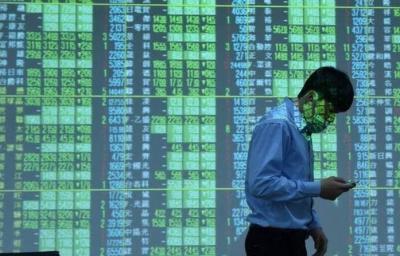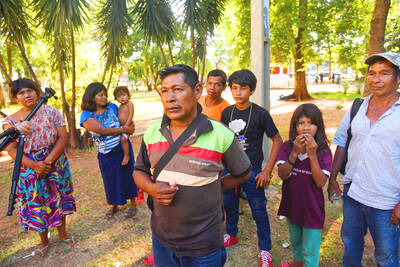Early last month, Romanian wheat farmer Costin Telehuz was brimming with optimism, especially after last year’s punishing drought. Then came the rain.
Three weeks of relentless downpours have hurt the harvest quality much more than the size. Now, he thinks just half of his crop is good enough to make the chewy dough used in bakery products, compared with the majority in a normal year. Much of the rest will end up as animal feed, fetching a lower price.
It is a similar picture elsewhere in the EU, the world’s No. 2 exporter, with areas of France and Germany also getting double normal rainfall in the past month.

Photo: Reuters
While Strategie Grains sees output rebounding about 12 percent this year after good spring showers, rain has taken its toll just as harvesting starts, risking fungal diseases and stalling tractors in soaked fields.
“We expect a very large rebound for EU crops,” Strategie Grains analyst Vincent Braak said. However, “a significant share” of the harvest would likely switch from milling to feed usage, he said.
Although than can threaten sales to key high-standard markets such as North Africa, there is much to cheer. The EU expects exports to rise 11 percent, and the bloc is a contender to steal market share from drought-hit North America and top shipper Russia, where export taxes have complicated trade. Plus, even lower-quality wheat might be in demand due to tight global feed-grain supplies.
Parts of Europe have in the past few days seen some of the most devastating floods in decades, and scientists warn that extreme weather events should increase as the planet warms.
Wetter-than-usual weather is expected throughout Germany from July 26 until early next month, a national forecaster said.
Milling-wheat prices extended a rally to a one-month high in Paris, while benchmark futures in Chicago headed for the biggest weekly surge in six years on concerns about adverse weather either side of the Atlantic.
In France, harvesting has been delayed, but wheat output should be above-average — as long as rain stops, Agritel commodities analyst Arthur Portier said.
Still, there is a threat to grain quality, which is crucial for trading with some major customers such as Algeria.
High freight costs could also hurt sales to far-away buyers, while keeping supply competitive in traditional markets nearer, crops office FranceAgriMer said.
Drier weather is expected next week, good news for farmers in the EU’s top grower.
Germany, the EU’s second-largest shipper also risks bacteria and fungal disease issues. Rain interrupted the collection of barley — which takes place before wheat — and more showers would prolong harvests, German farmers union DRV said.
“We have absolutely no concerns about the quantity,” said Johann Meierhoefer, agriculture division head at DBV, which sees winter-wheat output up 5 percent this year. “Speaking of qualities, the weather forecast is not as we would like to have it.”
Weather has definitely boosted volumes, with trader Cerealcom Dolj pegging output up 64 percent this year.
The country is among the first in the EU to start harvesting and has dominated tender sales in to top importer Egypt lately.
Yet heavy showers in Romania and Bulgaria have damaged quality.
Even so, the countries’ grain might appeal to nations in Southeast Asia, where there is healthy demand for feed wheat and concerns that Russia’s export tax could make purchases from there unreliable, Cerealcom risk manager Thomas Deevy said.
While Deevy said Romanian exports could accelerate, Telehuz described the mood as “a bit gloomy.”
“It’s not going to be a particularly bad harvest, but we really thought we’d be at the other end of the spectrum after what we endured last year,” said Telehuz, who farms in the Baragan Plain, a major grain region in the southeast.
Other commodities:
‧ Gold for August delivery fell US$14 to US$1,815 an ounce.
‧ Silver for September delivery fell US$0.59 to US$25.80 an ounce, while September copper was unchanged at US$4.32 a pound.
Additional reporting by AP and staff writer

SELL-OFF: Investors expect tariff-driven volatility as the local boarse reopens today, while analysts say government support and solid fundamentals would steady sentiment Local investors are bracing for a sharp market downturn today as the nation’s financial markets resume trading following a two-day closure for national holidays before the weekend, with sentiment rattled by US President Donald Trump’s sweeping tariff announcement. Trump’s unveiling of new “reciprocal tariffs” on Wednesday triggered a sell-off in global markets, with the FTSE Taiwan Index Futures — a benchmark for Taiwanese equities traded in Singapore — tumbling 9.2 percent over the past two sessions. Meanwhile, the American depositary receipts (ADRs) of Taiwan Semiconductor Manufacturing Co (TSMC, 台積電), the most heavily weighted stock on the TAIEX, plunged 13.8 percent in

A wave of stop-loss selling and panic selling hit Taiwan's stock market at its opening today, with the weighted index plunging 2,086 points — a drop of more than 9.7 percent — marking the largest intraday point and percentage loss on record. The index bottomed out at 19,212.02, while futures were locked limit-down, with more than 1,000 stocks hitting their daily drop limit. Three heavyweight stocks — Taiwan Semiconductor Manufacturing Co (TSMC, 台積電), Hon Hai Precision Industry Co (Foxconn, 鴻海精密) and MediaTek (聯發科) — hit their limit-down prices as soon as the market opened, falling to NT$848 (US$25.54), NT$138.5 and NT$1,295 respectively. TSMC's

TARIFFS: The global ‘panic atmosphere remains strong,’ and foreign investors have continued to sell their holdings since the start of the year, the Ministry of Finance said The government yesterday authorized the activation of its NT$500 billion (US$15.15 billion) National Stabilization Fund (NSF) to prop up the local stock market after two days of sharp falls in reaction to US President Donald Trump’s new import tariffs. The Ministry of Finance said in a statement after the market close that the steering committee of the fund had been given the go-ahead to intervene in the market to bolster Taiwanese shares in a time of crisis. The fund has been authorized to use its assets “to carry out market stabilization tasks as appropriate to maintain the stability of Taiwan’s

In a small town in Paraguay, a showdown is brewing between traditional producers of yerba mate, a bitter herbal tea popular across South America, and miners of a shinier treasure: gold. A rush for the precious metal is pitting mate growers and indigenous groups against the expanding operations of small-scale miners who, until recently, were their neighbors, not nemeses. “They [the miners] have destroyed everything... The canals, springs, swamps,” said Vidal Britez, president of the Yerba Mate Producers’ Association of the town of Paso Yobai, about 210km east of capital Asuncion. “You can see the pollution from the dead fish.